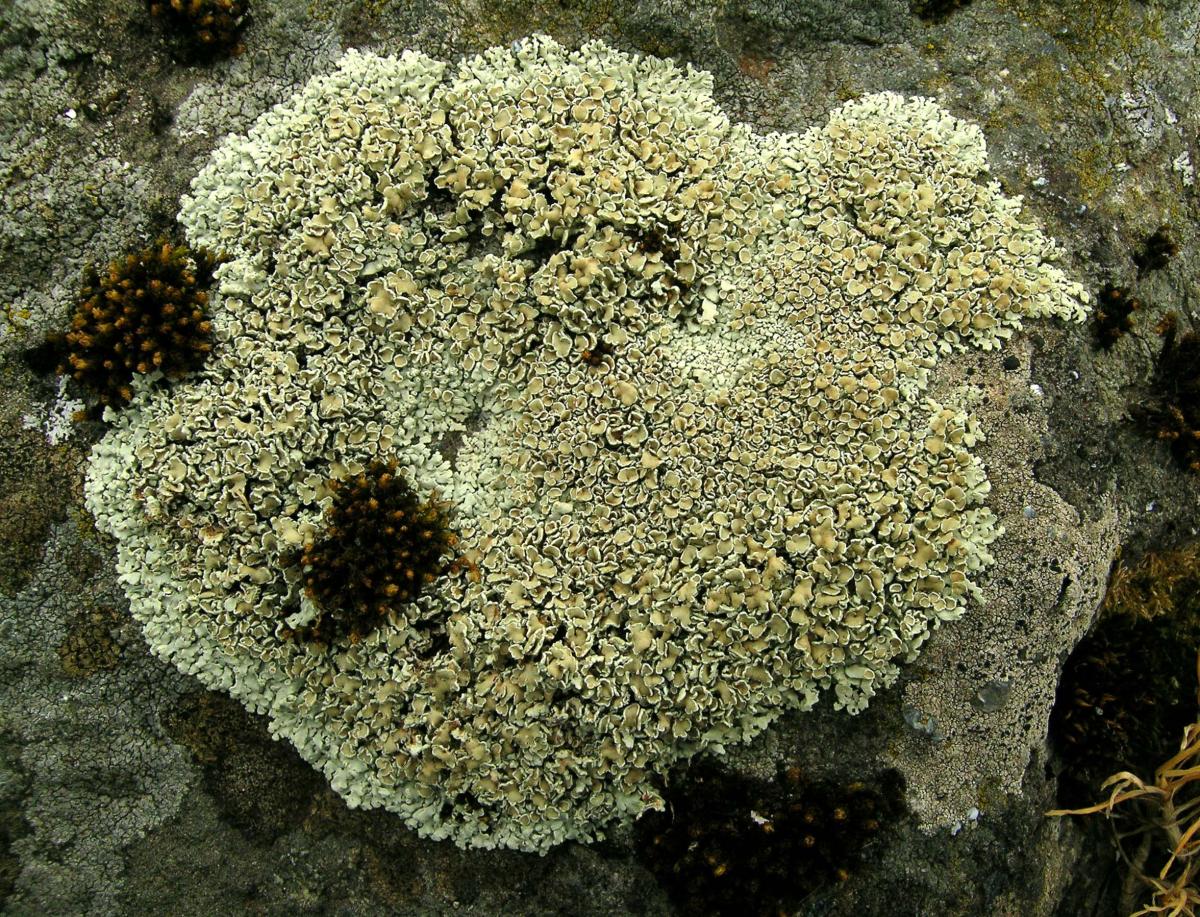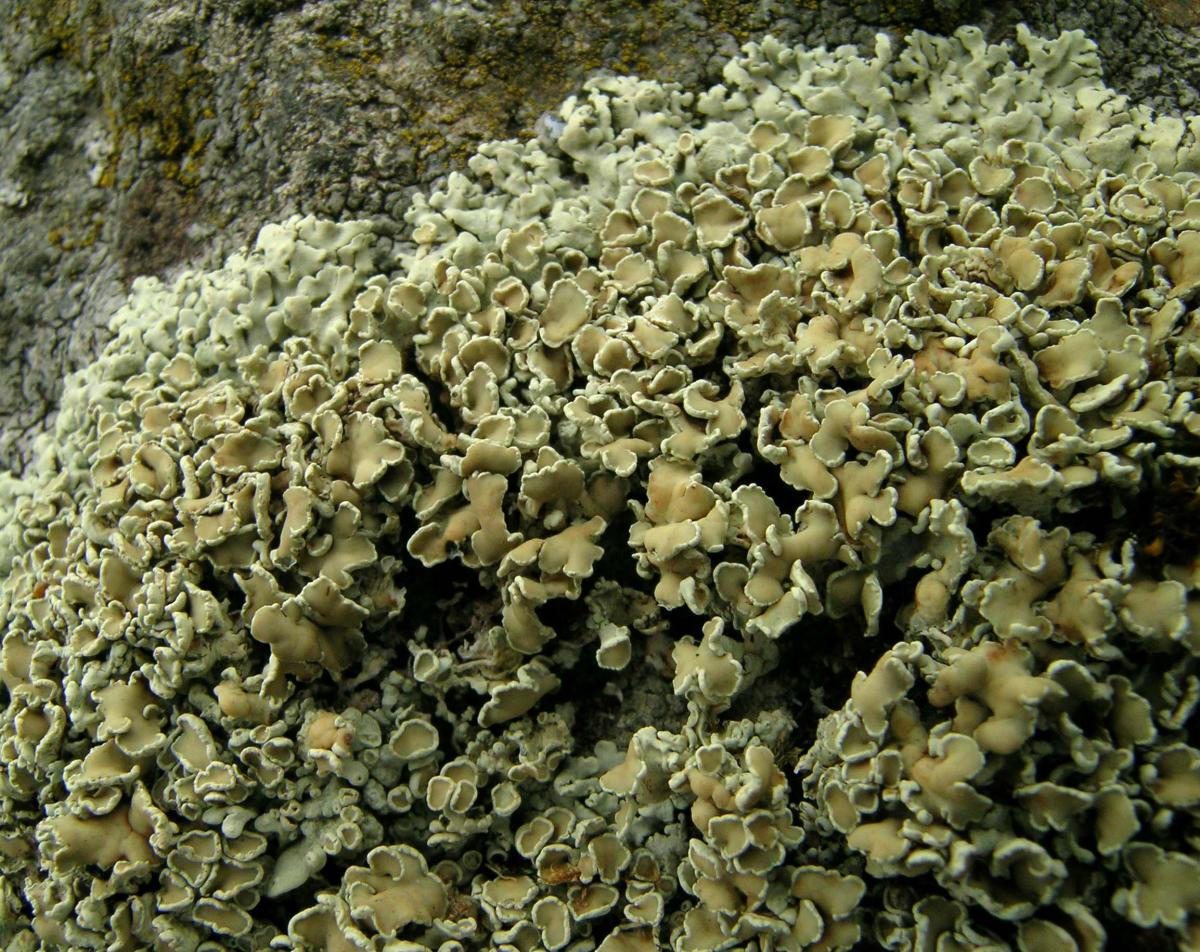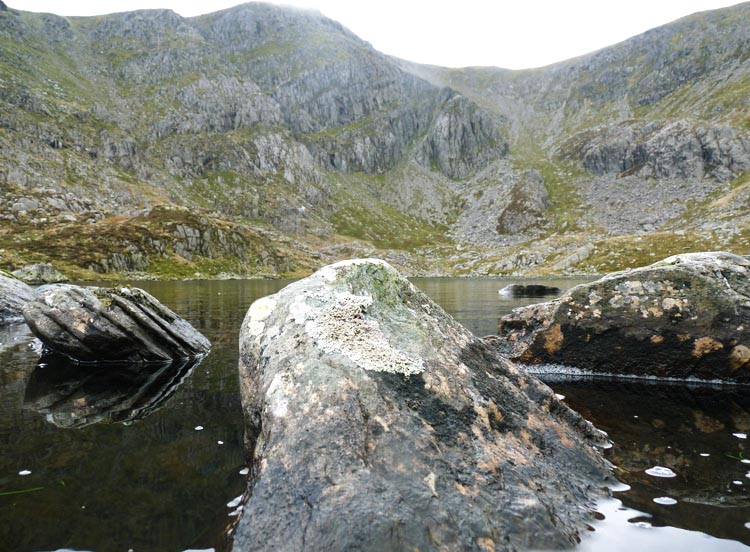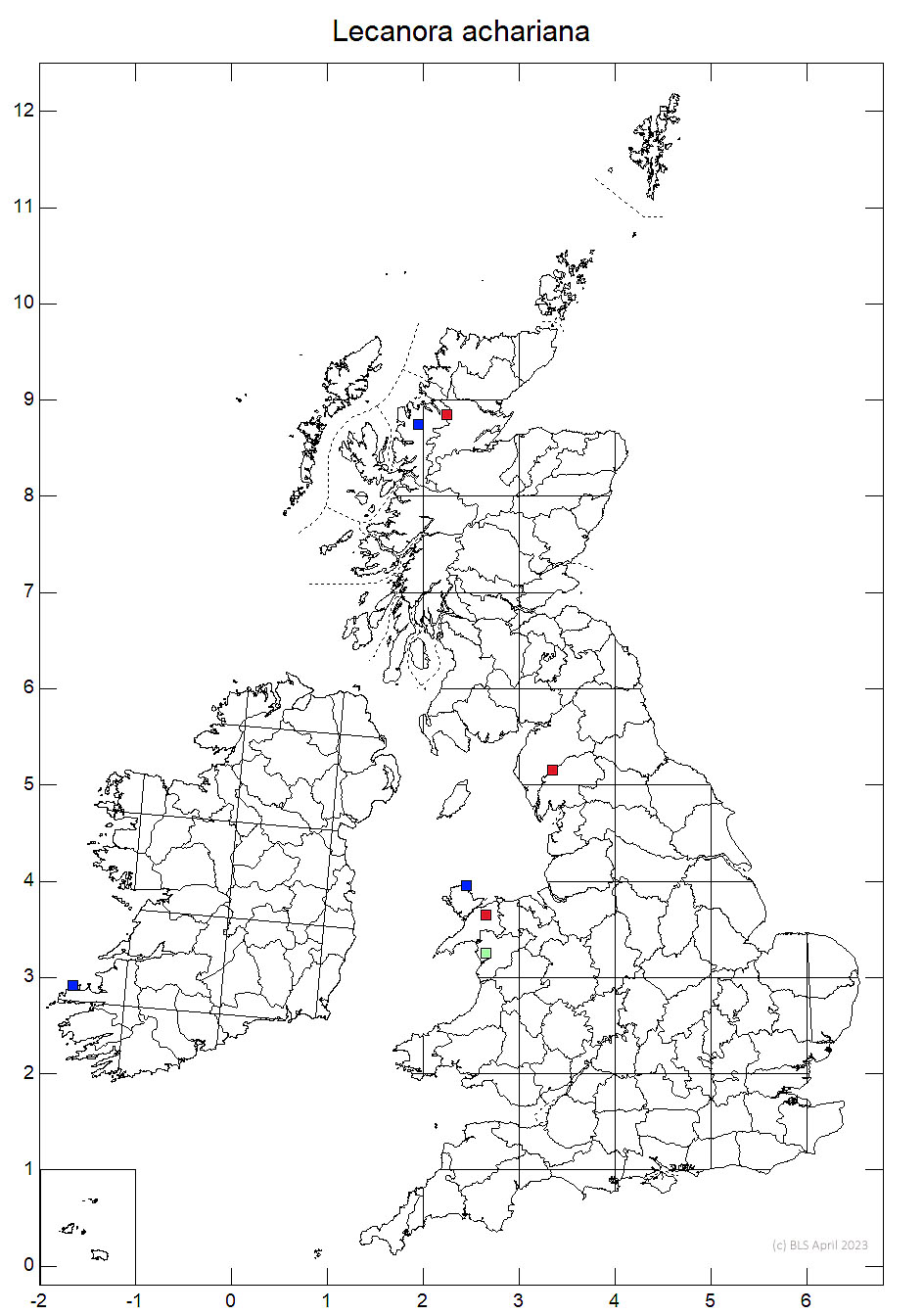Tarn lecanora
A species dossier for this lichen was produced by A.M. Fryday and B.J. Coppins in 1999 for Scottish Natural Heritage and the Royal Botanic Garden Edinburgh. This dossier reports in detail the world distribution and status, identification and ecology of the Tarn Lecanora and should be consulted. In summary they report this lichen to be confined to Europe with a concentration of sites in Scandinavia and a very local distribution elsewhere.
It produces loosely attached yellow to pale yellow-green, rosette-like lobed thalli on rocks in the splash zone of upland lakes and rarely in the flood zone of upland rivers. Apothecia are usually abundant in the thallus centre. They are dish like with a yellow crenate and wavy margin around a rose-brown to brown, non-pruinose disc.
It somewhat resembles Lecanora muralis which can occur in the same habitat. L. achariana is less appressed to the rock with lobes that tend to overlap towards the centre of the thallus giving it a chunkier appearance and the thallus is more yellow-green. Vince Giavarina says it appears in looks to be intermediate between L. muralis and Squamarina cartilaginea. The apothecia are also paler in colour than in L. muralis. RGW
 |
 |
| Photos: Alan Orange | |
L. achariana favours the tops of siliceous, well-lit boulders in upland situations that are occasionally inundated by spray or floodwater such as occur around lakes and beside rivers. Bird droppings enhance the nutrient status of the boulders and the associated water is not significantly acidified.

Photo: Ray Woods
In Wales it has been recorded from 3 sites. Specimens were collected from beside Llyn Bodlyn near Barmouth in 1835, 1862 and 1879. A recent search has failed to relocate it. The lake level was raised after 1879 to create an enlarged water supply for Barmouth. The lichen probably failed to adjust to the rapid change in water levels. Suitable boulders remain beside the lake. In 1997 the author having considered the limited habitat requirements of this species searched the CCW site records to identify a lake with marginal boulders that had not had its level artificially altered and was not significantly acidified. Ffynnon Lloer in Snowdonia was the only site that provided the necessary conditions. He contacted Oliver Gilbert who was familiar with this species who immediately visited the site and promptly located the lichen!
As the author was unable to trace any details regarding the size and extent of the population at Ffynnon Lloer and Dr Gilbert is now deceased, a site visit was made on the 20 October 2010 accompanied by Miss E. Fleming-Williams to collect additional data to provide a base-line for future surveillance of the population. The full report is appended to this species account. An extract is provided here.
Despite selecting what was forecast to be dry weather, on arrival at the lake high winds and light snowfall curtailed the survey. Not all boulders could be reached and the cold precluded wading. The following data nevertheless is believed to offer an adequate initial base-line survey.
An attempt was made to count all colonies. For the larger rapidly expanding individuals this lichen is an ideal subject. Unfortunately some boulders supported large coalescing colonies or others that were apparently breaking up. Bearing these limitations in mind at least 133 separate colonies were located on 25 boulders. It is suggested a target for favourable condition status be at least one hundred colonies on at least 20 boulders. A fragmenting and decaying population could meet this target so in addition it is considered that 75 of the colonies should be fertile and possess apothecia.
The following grid references circumscribe the extent of the lichen around the lake. All are in SH. The extent of the lichen should not diminish.
6624162053 Site of quadrat 1 (see below). 3 colonies on 1 boulder
6623162231 Site of quadrats 2 and 3. 15 & 4 colonies on 2 boulders
6620162068 Site of quadrat 4. 20 colonies on 4 boulders
6618862073 20+ colonies on 3 boulders
6615862081 6 colonies on 2 boulders
6614762072 25+ colonies on 4 boulders
6615762113 1 colony on 1 boulder
6624662160 6 colonies on 2 boulders
6626662174 5 colonies on 1 boulder
6630962199 26+ colonies on 2 boulders
6634462135 1 colony on 1 boulder
6633862097 1 colony on 1 boulder
Neither the suitable boulders nor the lichen is evenly distributed around the lake margin. The greatest concentrations occurred below the cliff towards the western end of the southern shore and along the north western quarter of the lake. Only a very small number of colonies were found on the northern and eastern shore line. The outflow stream was also examined and despite many suitable boulders being present and the site looking very like the outflow stream from Lochan Lathail, Ben Dearg SSSI in Scotland where this lichen also occurs, no colonies were found.
The lichen occupied a very limited zone on the tops and sides of boulders usually between 12 and 18cm above the level of the lake on the surveyed day. It should be noted that there had been neither a drought nor heavy rain preceding the visit and the lake was gently overflowing into the river suggesting that the level observed was neither exceptionally high or low.
The following 4 quadrats describe the percentage cover of associated species.
|
Quadrat No. |
1 |
2 |
3 |
4 |
|
Size (cm) of quadrat |
50x20 |
50x50 |
50x10 |
30x10 |
|
Lecanora achariana |
25 |
20 |
5 |
70 |
|
Lecanora muralis |
20 |
50 |
25 |
|
|
Aspicilia caesiocinerea |
20 |
20 |
30 |
15 |
|
Xanthoparmelia conspersa |
8 |
2 |
5 |
|
|
Rhizocarpon geographicum |
5 |
5 |
1 |
|
|
Racomitrium aciculare |
2 |
1 |
15 |
10 |
|
Hypnum cupressiforme |
1 |
|
10 |
3 |
|
Pertusaria pseudocoralina |
8 |
|
|
|
|
Brachythecium plumosum |
10 |
|
1 |
|
|
Dermatocarpon weberi |
5 |
|
|
|
|
Candelariella vitellina |
1 |
|
|
|
|
Undetermined crustose lichens |
1 |
|
10 |
10 |
In the Afon Llafer above Bethesda in 1998 Alan Orange noted that Lecanora achariana grew in a similar community on the upper surface of boulders between 100 and 200mm above the river water level on the day of the visit. It was associated with the lichens Hymenelia lacustris, Lecanora muralis, Aspicilia caesiocinerea and the moss Schistidium rivulare. Oribatid mites were seen to be grazing the Tarn Lecanora, preferentially browsing the hymenium of the fruit bodies.
At Ffynnon Lloer other species occurring on boulders around the lake margin included the mosses Climacium dendroides and Pterogonium gracile suggesting a somewhat basic substrate. Hedwigia ciliata was also noted on the top of a number of boulders. This is the first modern record from North Wales and the first recent record from a natural habitat in Wales.(RGW)
Any rapid alteration of water levels would threaten this species as would any significant change in water chemistry. Gross eutrophication as might result from an excessive number of birds roosting could pose a threat, though bird guanu in smaller amounts is probably essential to its well being. The continued acidification of upland Wales poses a threat should natural buffering capacity be exceeded. There are a number of hydroelectric proposals on streams in Snowdonia including the Llafer. Careful consideration would be required of any proposal as at present no data appears to exist concerning the necessary inundation periods that this lichen clearly requires.
In Britain it is considered to be “critically endangered” whilst in Wales “endangered “status was considered more appropriate since neither population appeared threatened. This may need to be revised to “critically endangered”. RGW
- Log in to post comments

